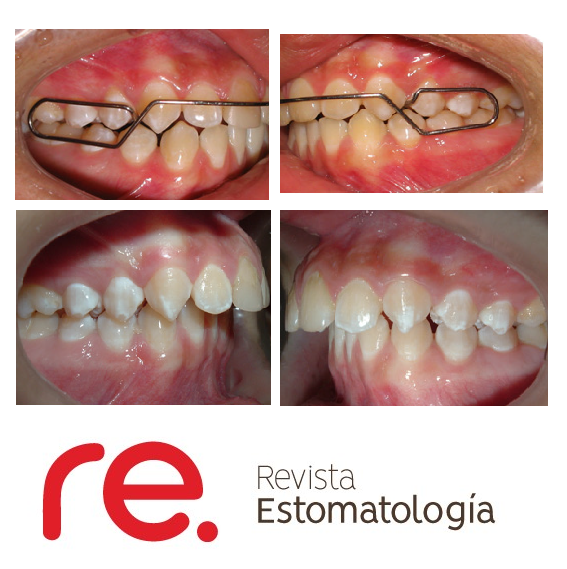Treatment of malocclusion class II with orthopedic functional apliances: Bionator. A case report
Main Article Content
The efficiency of correction of Class II malocclusion, using functional appliances have been reported in the literature some time ago. Several studies have showed how functional orthopedic appliances act on bone, muscle, and dental structures of patients who are at stages prior to the pubertal growth peak.
Functional appliances take advantage of the natural forces of growth and development which achieves a normal function of the stomatognathic system that ensures adequate chewing, swallowing, speech, aesthetics and improving patient’s self-esteem at early age.
The purpose of this case report is to show how satisfactory results are achieved with the treatment of Class II division 1 malocclusion in young patients using a functional appliance as Dr. Balters Bionator. Also to present the positive facial, dental and cephalometric changes, which were the result of proper diagnosis, proper selection of the appliance and excellent cooperation of the patient.
- Maxillary orthopedics
- early treatment
- class II malocclusion
- Bionator
2. Charlier J, Petrovic A, Herrmann-Stutzmann J. Effects of mandibular hyper-propulsion on the precondroblastic zone of young rat condyle. Am J Orthod 1969; 55:71
3. Voudouris JC, Kuftinec MM. Improved clinical use of Twin-block and Herbst as a result of radiating viscoelastic tissue forces on the condyle and fossa in treatment and long-term retention: growth relativity. Am J Orthod Dentofacial Orthop 2000; 117:247-66.
4. De Almeida MR, Henriques JFC, Ursi W. Comparative study of the Fränkel (FR-2) and bionator appliances in the treatment of Class II malocclusion. American Journal of Orthodontics and Dentofacial Orthopedics 2002; 121(5):458-466.
5. Keeling SD, Wheeler TT, King GJ, Garvan CW, Cohen DA, Cabassa S, McGorray SP, Taylor MG. Anteroposterior skeletal and dental changes after early Class II treatment with bionators and headgear. American Journal of Orthodontics and Dentofacial Orthopedics 1998; 113:40-50.
6. Wheeler TT, McGorray SP, Dolce C, Taylor MG, King GJ. Effectiveness of early treatment of Class II malocclusion American Journal of Orthodontics and Dentofacial Orthopedics 2002; 121:9-17.
7. Garattini G, Levrini L, Crozzoli P, Levrini A. Skeletal and dental modifications produced by the Bionator III appliance. American Journal of Orthodontics and Dentofacial Orthopedics 1998; 114:40-44.
8. Ahn SJ, Kim, JT, Nahm DS. Cephalometric markers to consider in the treatment of class II division 1 malocclusion with the Bionator. American Journal of Orthodontics and Dentofacial Orthopedics 2001; 119(6):578-586.
9. Rutter RR, Witt E. Correction of Class II, Division 2 malocclusions through the use of the Bionator appliance report of two cases. American Journal of Orthodontics and Dentofacial Orthopedics 1990; 97(2):106-112.
10. Woodside D.G, Metaxas. A, Altuna G. The influence of functional appliance therapy on glenoid fossa remodeling, Am Journal of orthodontics and dentofacial orthopedics 1987; 92:181-98
11. Chen JY, Will LA, Niederman R. Analysis of efficacy of functional appliances on mandibular growth. American Journal of Orthodontics and Dentofacial Orthopedics 2002; 122(5):470-476.
12. Mamandras AH, Allen L P Mandibular response to orthodontic treatment with the Bionator appliance. American Journal of Orthodontics and Dentofacial Orthopedics 1990; 97(2):113-120.
13. Tulloch JFC, Proffit WR, Phillips. Influences on the outcome of early treatment for Class II malocclusion. American Journal of Orthodontics and Dentofacial Orthopedics 2004; 125(1): 123.
14. Tulloch JFC, Phillips C, Proffit WR .Benefit of early Class II treatment: Progress report of a two-phase randomized clinical trial. American Journal of Orthodontics and Dentofacial Orthopedics 1998; 113(1): 62-72.
15. Proffit WR, Tulloch JFC. Preadolescent Class II problems: Treat now or wait?. American Journal of Orthodontics and Dentofacial Orthopedics 2002; 121(6):60-562.
16. Baccetti T, Stahl F, McNamara J. Dentofacial growth changes in subjets with untreated clas II malocclusion from late puberty through young adulthood, Am journal orthod dentofacial orthopedics 2009; 135:148-54
17. DeVincenzo JP. Changes in mandibular length before, during, and after successful orthopedic correction of Class II malocclusions, using a functional appliance. American Journal of Orthodontics and Dentofacial Orthopedics 1991; 99(3):241-257.
18. You ZH, Fishman LS, Rosenblum RE, Subtelny J. D Dentoalveolar changes related to mandibular forward growth in untreated Class II persons. American Journal of Orthodontics and Dentofacial Orthopedics 2001; 120(6):598-607.
19. Edwards IG. Facial growth: A refined paradigm. American Journal of Orthodontics and Dentofacial Orthopedics 1998; 114(6):16-17.
20. Rabie ABM. Does the degree of advancement during functional appliance therapy matter? European Journal of Orthodontics 2008; 30:274-282.
21. Rabie ABM. Replicating mesenchymal cell in the condyle and the glenoid fossa during mandibular forward positioning. Am J Orthodo and Dentofacial Orthopedics 2003; 123:49-57.
22. Shum L. Vascular endothelial growth factor expression and bone formation in posteriornglenoid fossa during stepwise mandibular advancement.Am J Orthod and Dentofacial Orthop 2004; 125:185-90.
23. Gupta A, Kohli V, Hazarey P, Kharbanda O, Gunjal A. Stress distribution in the temporomandibular joint after mandibular protraction: A 3-dimensional finite element method study. Part 1. Am J Orthod Dentofacial Orthop 2009; 135:737-48.
24. Jacobson A. Dentofacial orthopedics with functional appliances, Second Edition. American Journal of Orthodontics and Dentofacial Orthopedics 1998; 113(6,):1.
25. Bedoya A, Chacón A. Tratamiento temprano de maloclusiones clase II tratadocon Activador Abierto Elástico de Klammt (AAEK).Reporte de caso. Rev Estomat 2009; 17(2):23-29.
Downloads
Los autores/as conservan los derechos de autor y ceden a la revista el derecho de la primera publicación, con el trabajo registrado con la licencia de atribución de Creative Commons, que permite a terceros utilizar lo publicado siempre que mencionen la autoría del trabajo y a la primera publicación en esta revista.





